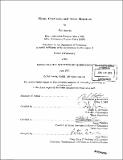Firms, contracts, and trade structure
Author(s)
Antràs, Pol
DownloadFull printable version (7.061Mb)
Other Contributors
Massachusetts Institute of Technology. Dept. of Economics.
Advisor
Daron K. Acemoglu and Jaume Ventura.
Terms of use
Metadata
Show full item recordAbstract
This dissertation consists of three essays in the intersection of the theory of international trade and the theory of the firm. The first essay starts by unveiling two systematic patterns in the volume of intrafirm trade. I then show that these patterns can be rationalized in a theoretical framework that combines a Grossman-Hart-Moore view of the firm with a Helpman-Krugman view of international trade. In particular, I develop an incomplete-contracting, property-rights model of the boundaries of the firm, which I then incorporate into a standard trade model with imperfect competition and product differentiation. The model pins down the boundaries of multinational firms as well as the international location of production. Econometric evidence reveals that the model is consistent with other qualitative and quantitative features of the data. In the second essay, I develop a dynamic, general-equilibrium Ricardian model of North-South trade, in which the incomplete nature of contracts governing international transactions leads to the emergence of product cycles. Following the property-rights approach to the theory of the firm, the same force that creates product cycles, i.e. incomplete contracts, opens the door to a parallel analysis of the determinants of the mode of organization. The model is shown to deliver endogenous organizational cycles. I discuss several macroeconomic and microeconomic implications of the model and relate them to the previous literature on the product cycle. The third essay, co-authored with Professor Helpman from Harvard University, provides a theoretical framework for studying global sourcing strategies. In our model, heterogeneous final-good producers choose organizational forms. That is, they choose ownership structures and locations for the production of intermediate inputs. (cont.) We describe an equilibrium in which firms with different productivity levels choose different ownership structures and supplier locations. We then study the effects of within-sectoral heterogeneity and variations in industry characteristics on the relative prevalence of these organizational forms. The analysis sheds light on the structure of foreign trade within and across industries.
Description
Thesis (Ph. D.)--Massachusetts Institute of Technology, Dept. of Economics, 2003. Includes bibliographical references (p. 163-171).
Date issued
2003Department
Massachusetts Institute of Technology. Department of EconomicsPublisher
Massachusetts Institute of Technology
Keywords
Economics.